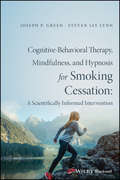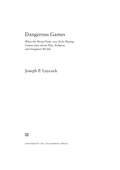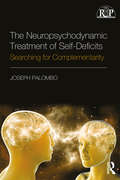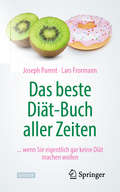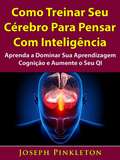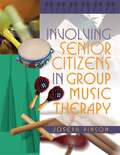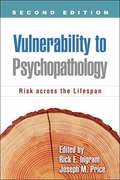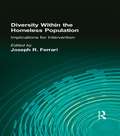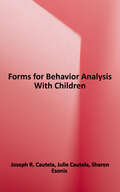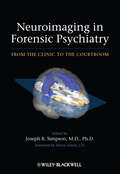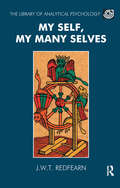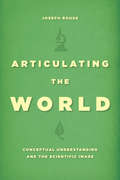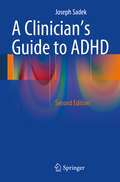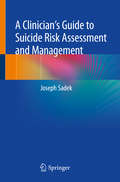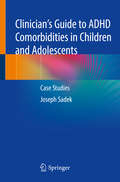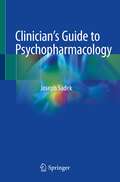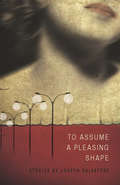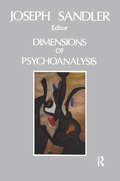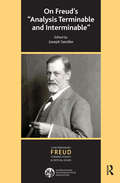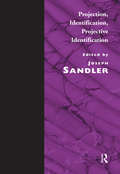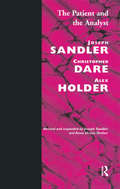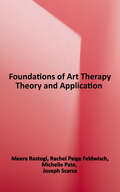- Table View
- List View
Cognitive-Behavioral Therapy, Mindfulness, and Hypnosis for Smoking Cessation: A Scientifically Informed Intervention
by Steven Jay Lynn Joseph P. GreenCognitive-Behavioral Therapy, Mindfulness, and Hypnosis for Smoking Cessation: A Scientifically Informed Intervention presents a comprehensive program developed by noted experts to help smokers achieve their goal of life-long abstinence from smoking. This brief, cost-effective intervention, called The Winning Edge, incorporates state-of-the-science advances and best clinical practices in the treatment of tobacco addiction and offers participants a unique blend of strategies based on cognitive-behavioral, mindfulness, and hypnotic approaches to achieve smoking cessation. This valuable treatment guide, developed and refined over the past 30 years, provides all of the information necessary for health care providers to implement the program on a group or individual basis. <p><p> This important resource: <p><p> Provides a detailed, step-by-step guide to conducting the program, with scripts for providers and handouts for participants Explains the scientific basis for the many strategies of cognitive, behavioral, and affective change in The Winning Edge program Contains information for treatment providers on frequently asked questions, adapting and tailoring the program to the needs of participants, and overcoming challenges, ambivalence, and resistance to stop smoking <p><p>Written for a wide audience of mental health professionals, Cognitive-Behavioral Therapy, Mindfulness, and Hypnosis for Smoking Cessation: A Scientifically Informed Intervention offers a comprehensive, science-based approach to help participants achieve their goal of a smoke-free life.
Dangerous Games: What the Moral Panic over Role-Playing Games Says about Play, Religion, and Imagined Worlds
by Joseph P. LaycockThe 1980s saw the peak of a moral panic over fantasy role-playing games such as "Dungeons and Dragons. " A coalition of moral entrepreneurs that included the Christian Right, psychologists, and law enforcement claimed these games were not only psychologically dangerous but an occult religion masquerading as a game. "Dangerous Games" explores both the history and the sociological significance of this panic. Fantasy role-playing games do share several functions in common with religion. However, religion as a socially constructed world of shared meaning can also be compared to a fantasy role-playing game. In fact, the claims of the moral entrepreneurs, in which they presented themselves as heroes battling a dark conspiracy, often resembled the very games of imagination that they condemned as evil. By attacking the imagination, they preserved the taken-for-granted status of their own socially constructed reality. Interpreted in this way, the panic over fantasy-role playing games yields new insights about how humans play and together construct and maintain meaningful worlds. Laycock s clear and accessible writing ensures "Dangerous Games" will be required reading for those with an interest in religion, popular culture, and social behavior, in the classroom and beyond. "
The Neuropsychodynamic Treatment of Self-Deficits: Searching for Complementarity (Relational Perspectives Book Series)
by Joseph PalomboThe Neuropsychodynamic Treatment of Self-Deficits examines how to work psychoanalytically with patients to address the problems that result from neuropsychological impairments, exploring the latest advances in understanding and treatment, while also addressing the concerns that clinicians may have in providing treatment. Patients with disorders such as ADHD, dyslexia, and executive function disorders can often feel shame, and develop defenses as a result of their disorders. These defenses can then become overgeneralized and lead to future dysfunctional feelings, thoughts and behaviors. For therapists, the challenge is to find ways of responding to these patients and to help them deal with their issues at the level of the multiple domains of self-experience, rather than at the single level of their intrapsychic dynamics. This book proposes a new neuropsychodynamic perspective that is bound together by a metatheory, deriving from dynamic systems theory. Joseph Palombo breaks new ground in his consistent application of non-linear dynamic systems theory and a levels-of-analysis perspective. The framework suggested conceives of the therapeutic process as a collaborative effort in which each member of the dyad makes a unique contribution to the process. Change agents that permit patients to benefit from therapeutic interventions include the relationship between patient and therapist, the understanding that emerges from the identification of the self-deficits, and the proactive engagement of the patient’s sense of agency. The great advantage of Palombo’s framework is that it permits the integration of a broad set of domains of experience that include the neuropsychological, the introspective, and the interpersonal. This book will allow the reader to become familiar with the types of patients that have neuropsychological deficits, providing an understanding of the psychodynamics of these conditions and enabling better preparedness to address psychological needs. More important, Palombo also makes the underlying case that an understanding of brain function is critical to any assistance such patients may need. Covering work with children, adolescents, and adults, The Neuropsychodynamic Treatment of Self-Deficits is the first book to offer a guide to understanding and working with patients with a range of neuropsychological disorders from a broadly psychoanalytic perspective. It will appeal to psychoanalysts, psychotherapists, and clinical psychologists, as well as clinical social workers, family therapists, and mental health nurses.
Das beste Diät-Buch aller Zeiten: ... wenn Sie eigentlich gar keine Diät machen wollen
by Joseph Parent Lars FrormannBei diesem Buch handelt es sich nicht um eines der zahlreichen und üblichen Bücher über die Dinge, die man essen oder meiden soll, um abzunehmen. Es enthält keine Rezepte oder Anweisungen, sondern psychologische Strategien, Tipps und "mentale" Gedanken, um mühelos und ohne zu hungern abzunehmen. Leicht verständlich werden in diesem Buch basierend auf psychologischen Verhaltensmodellen und achtsamkeitsbasierten Verfahren Strategien sowie praktische Übungen vorgestellt (das NINJA-System, Positive Choice Model) und bekannte Fallen aufgezeigt, um Leser*innen das Abnehmen (egal mit welcher Diät) zu erleichtern.In den USA gibt es zahlreiches positives Feedback und entsprechende Erfolgsmeldungen bzgl. des erreichten Gewichtsverlust sowie gesünderen Lebensweise.
Como Treinar Seu Cérebro Para Pensar Com Inteligência: Aprenda a Dominar Sua Aprendizagem, Cognição e Aumente o Seu QI
by Joseph PinkletonVocê gostaria de ser capaz de pensar com inteligência de uma maneira clara? Por muito tempo as técnicas de pensamento inteligente e pensamento crítico tem sido utilizadas para melhoras todos os aspectos das vidas das pessoas! Utilizar o pensamento inteligente ajuda as pessoas a terem uma vida mais saudável e próspera. O que você aprenderá com o livro: - Fazer decisões inteligentes. - Melhorar Relacionamentos. - Melhorar seu potencial de Ganho. - Melhorar sua energia. - Melhorar sua saúde geral. + MUITO MAIS! --> Role para o topo da página e clique em “adicionar ao carrinho” pra comprar imediatamente
Involving Senior Citizens in Group Music Therapy
by Joseph PinsonThis practical guide to running music therapy groups with senior citizens provides effective strategies that encourage therapists to be creative and engaging, and involve participants fully in the music-making process. Ideal for those working with older people in assisted living or nursing care homes, the book covers initial assessment, setting measurable goals, and evaluating progress; discusses current music therapy techniques; and offers an improved plan of intervention. The author explains how to choose or create music that is accessible to this age group, designing strategies that utilize cognitive, motor, social-emotional, and music skills to the fullest. The book provides useful original music and shows readers how to compose their own songs that relate to the experiences of the group they are working with, emphasizing shared common interests and enjoyment in the moment.
Involving Senior Citizens in Group Music Therapy
by Joseph PinsonThis practical guide to running music therapy groups with senior citizens provides effective strategies that encourage therapists to be creative and engaging, and involve participants fully in the music-making process.Ideal for those working with older people in assisted living or nursing care homes, the book covers initial assessment, setting measurable goals, and evaluating progress; discusses current music therapy techniques; and offers an improved plan of intervention. The author explains how to choose or create music that is accessible to this age group, designing strategies that utilize cognitive, motor, social-emotional, and music skills to the fullest. The book provides useful original music and shows readers how to compose their own songs that relate to the experiences of the group they are working with, emphasizing shared common interests and enjoyment in the moment.
Vulnerability to Psychopathology, Second Edition: Risk across the Lifespan
by Joseph Price Rick IngramThis state-of-the-art work has been highly praised for bridging the divide between adult and developmental psychopathology. The volume illuminates the interplay of biological, cognitive, affective, and social-environmental factors that place individuals at risk for psychological disturbance throughout development. Childhood-onset and adult forms of major disorders are examined in paired chapters by prominent clinical researchers. An integrative third chapter on each disorder then summarizes what is known about continuity and change in vulnerability across the lifespan. Implications for assessment, treatment, and prevention are also considered.
Diversity Within the Homeless Population: Implications for Intervention
by Joseph R FerrariAn important contribution to the understanding of the unique circumstances and needs of the homeless, Diversity Within the Homeless Population examines why more and more women and their children, adolescents, and young adults are ending up on the street. You will learn about unique treatment and community intervention programs, preventive approaches that target those at risk for future homelessness, and case management as a strategy for preventing the initial experience of homelessness. You will also learn about the ”behavioral” factors that differentiate homeless women with children from impoverished women with children who remain housed, including domestic violence, degree of education, number of children, traumatic experiences, and use of drugs. You&’ll find this dynamic book takes a giant step toward the development and evaluation of strategies for preventing and alleviating this urgent social problem. In doing so, Diversity Within the Homeless Population explores the benefits of family-oriented treatment, ways to make housing available to the homeless through employment opportunities, and the effectiveness of linking inpatient treatment to a culturally sensitive, community-based intervention program. You will also learn about: the lack of personal support networks among the homeless crack/cocaine use and homelessness among inner-city communities preventing relapse among crack-using homeless women with children the “Needs Foundation” in Chicago social and environmental predictors of adjustment in homeless children homelessness and how it compromises the behavioral, physical, social, cognitive, and emotional development of children hierarchical multiple regression analyses system and agency demands on case managersAs a researcher, social worker, psychologist, or counselor who works with the homeless, you face extraordinary adversity on a daily basis; this book offers you hope, guidance, insight, and intervention strategies that will aid you in tackling this enormous social problem. Diversity Within the Homeless Population provides you with a storehouse of ideas that you’ll implement in your own practice or community.
Forms for Behavior Analysis With Children
by Joseph R. Cautela Julie Cautela Sharon EsonisA unique collection of 42 reproducible assessment forms designed to aid counselors and therapists in making proper diagnoses and in developing treatment plans for children and adolescents. Different assessment formats are included, ranging from direct observations and interviews to informant ratings and self-reports. Certain forms are to be filled out by children and adolescents, while others are to be completed by parents, school personnel, significant others, or the therapist.
Neuroimaging in Forensic Psychiatry: From the Clinic to the Courtroom
by Joseph R. SimpsonThis important volume is the first to address the use of neuroimaging in civil and criminal forensic contexts and to include discussion of prior precedents and court decisions. Equally useful for practicing psychiatrists and psychologists, it reviews both the legal and ethical consideraitons of neuroimaging.
My Self, My Many Selves
by Joseph Redfearn'The concept of the "self" has remained puzzling and controversial. Indeed, far from gaining clarity, it seems to become ever more complex; for many different people, starting from different premises and having different goals have come to "appropriate" this term. The author has made what seems to me to be a most valuable contribution by sticking firmly to an experiential approach. The author has thought hard and deeply about the different ways in which we experience the "I" and drawn on his own "I" experience as well as on those of his patients and Jung himself. 'The author tells us in his introduction that the main aim of his book is to illustrate the migratory nature of the feeling of "I" and that the goal of analysis is to "facilitate and open up interaction and intercommunication between our various selves".
Articulating the World: Conceptual Understanding and the Scientific Image
by Joseph RouseNaturalism as a guiding philosophy for modern science both disavows any appeal to the supernatural or anything else transcendent to nature, and repudiates any philosophical or religious authority over the workings and conclusions of the sciences. A longstanding paradox within naturalism, however, has been the status of scientific knowledge itself, which seems, at first glance, to be something that transcends and is therefore impossible to conceptualize within scientific naturalism itself. In Articulating the World, Joseph Rouse argues that the most pressing challenge for advocates of naturalism today is precisely this: to understand how to make sense of a scientific conception of nature as itself part of nature, scientifically understood. Drawing upon recent developments in evolutionary biology and the philosophy of science, Rouse defends naturalism in response to this challenge by revising both how we understand our scientific conception of the world and how we situate ourselves within it.
A Clinician's Guide to ADHD
by Joseph SadekThe Clinician's Guide to ADHD combines the useful diagnostic and treatment approaches advocated in different guidelines with insights from other sources, including recent literature reviews and web resources. The aim is to provide clinicians with clear, concise, and reliable advice on how to approach this complex disorder. The guidelines referred to in compiling the book derive from authoritative sources in different regions of the world, including the United States, Canada, Australia, and Europe. After introductory discussion of epidemiology and etiology, guidance is provided on diagnosis in different age groups, differential diagnosis, assessment for potential comorbidities, and the issue of ADHD and driving. Advice is then given on the appropriate use of pharmacological and psychosocial treatment, the management of adverse events, and follow-up. A series of relevant scales, questionnaires, and websites are also included.
A Clinician’s Guide to Suicide Risk Assessment and Management
by Joseph SadekThis book offers mental health clinicians a comprehensive guide to assessing and managing suicide risk. Suicide has now come to be understood as a multidimensionally determined outcome, which stems from the complex interaction of biological, genetic, psychological, sociological and environmental factors. Based on recent evidence and an extensive literature review, the book provides straightforward, essential information that can easily be applied in a wide variety of disciplines.
Clinician’s Guide to ADHD Comorbidities in Children and Adolescents: Case Studies
by Joseph SadekThe diagnosis and management of ADHD co-occurring with other disorders such as anxiety, depression, tics and substance use remain major challenges for clinicians treating all age groups. This book guides clinicians trough each step in the diagnosis and management of the comorbidity through essential case studies describing psychiatric disorders that frequently occur with child ADHD are well described in every case. Each case includes a diagnosis section and management section and is accompanied by questions and answers concerning the most important aspects in diagnosing and managing of both ADHD and the comorbid disorders. Drawn from actual clinical encounters, the case studies also feature ample current and valid references.
Clinician’s Guide to Adult ADHD Comorbidities: Case Studies
by Joseph SadekThe diagnosis and management of ADHD co-occurring with other disorders such as anxiety, depression and personality disorders remain major challenges for clinicians treating all age groups. This book guides clinicians through each step in the diagnosis and management of the comorbidities of adult ADHD on the basis of essential case studies describing psychiatric disorders that frequently occur with ADHD. Each case includes a diagnosis section and management section and is accompanied by questions and answers concerning the most important aspects in diagnosing and managing both ADHD and the comorbid disorders. Drawn from actual clinical encounters, the case studies also feature ample current and valid references.
Clinician’s Guide to Psychopharmacology
by Joseph SadekThis book employs a direct and clear approach to understanding the medications used in the treatment of psychiatric disorders. A range of areas, such as prescription errors, dosage modification in renal and hepatic dysfunction, augmentation strategies in treatment resistant patients, and recent findings from various clinical trials are addressed. Given its clear, straightforward approach, the book will be a valuable guide for all clinicians working with patients with psychiatric illness.
To Assume a Pleasing Shape
by Joseph SalvatoreA body-pierced goth girl cage-dances for a living while putting herself through school. A New York City academic reevaluates her closest relationships while considering breast-reduction surgery. A chatty Gulf War veteran is plagued by a sexual identity crisis. The characters in this debut short story collection search for meaning through the crucible of sex. Joseph Salvatore's top-notch literary writing coaxes readers into murky territories as characters spiral deeper into existential rabbit holes. Joseph Salvatore reviews fiction for The New York Times Book Review. He teaches at The New School where he founded their literary journal LIT. He lives in New York.
To Assume a Pleasing Shape (American Readers Series)
by Joseph SalvatoreA body-pierced goth girl cage-dances for a living while putting herself through school. A New York City academic reevaluates her closest relationships while considering breast-reduction surgery. A chatty Gulf War veteran is plagued by a sexual identity crisis. The characters in this debut short story collection search for meaning through the crucible of sex. Joseph Salvatore's top-notch literary writing coaxes readers into murky territories as characters spiral deeper into existential rabbit holes. Joseph Salvatore reviews fiction for The New York Times Book Review. He teaches at The New School where he founded their literary journal LIT. He lives in New York.
Dimensions of Psychoanalysis: A Selection of Papers Presented at the Freud Memorial Lectures
by Joseph SandlerThis book contains a selection of the Sigmund Freud Memorial Lectures on psychoanalytic psychology delivered by eminent British, French and American analysts, pointing out that there is a tendency to consider pathological processes in terms of the vicissitudes of the person's object relationships.
On Freud's Analysis Terminable and Interminable (Ipa - The Contemporary Freud: Turning Points And Critical Issues Ser.)
by Joseph SandlerA discussion by several analysts on the length of treatment, based upon Freud's paper, which is also included. Contributors include Andre Green, Arnold Cooper and David Rosenfeld.
Projection, Identification, Projective Identification
by Joseph SandlerThis book focuses on all aspects of projection and identification, and addresses the problems and perplexities of projective identification. It is based on the First Conference of the Sigmund Freud Center of the Hebrew University of Jerusalem.
The Patient and the Analyst: The Basis of the Psychoanalytic Process
by Joseph SandlerThis is a completely revised and enlarged edition of the well-known classic. In the twenty years since the previous edition was published much progress has been made in regard to the clinical concept of psychoanalysis, and this new edition brings the subject completely up to date. New knowledge of the psychoanalytic process has been added, together with advances in understanding the clinical situation, the treatment alliance, transference, countertransference, resistance, the negative therapeutic reaction, acting out, interpretations and other interventions, insight, and working through. The book is both a readable introduction to the subject and an authorities work of reference.
Foundations of Art Therapy: Theory and Applications
by Joseph Scarce Meera Rastogi Rachel P. Feldwisch Michelle PateThis is an essential and comprehensive introduction to the field of art therapy that blends relevant psychological and neuroscience research, theories, and concepts and infuses cultural diversity throughout each chapter. <p><p>The text includes full color photos, informative charts, and case examples and is divided into four parts beginning with the basics of art therapy knowledge and concluding with professional practices in art therapy. The fundamentals of art therapy section includes coverage of art therapy founders, art materials, multicultural perspectives, intersections with neuroscience, and research methods. <p><p>An overview and in-depth explorations of different theoretical approaches to the practice of art therapy are covered in the second part of the book. A bio-psycho-social approach integrates current research on art therapy with specific populations (children, mental health, older adults, and trauma). <p><p>The book concludes with art therapy professional practices in group concepts, community-based art therapy, and developing a career in the field. Each chapter contains chapter objectives, practical applications, ethical considerations, reflection questions, experiential exercises, and a list of terms. The unique, practical, and interdisciplinary approach of this text provides a solid base for understanding the field of art therapy and is well suited for use in undergraduate art therapy courses. This book will appeal to those who want an introduction to the field's theories, research, and practice and those seeking a comprehensive understanding on the foundations of art therapy.
